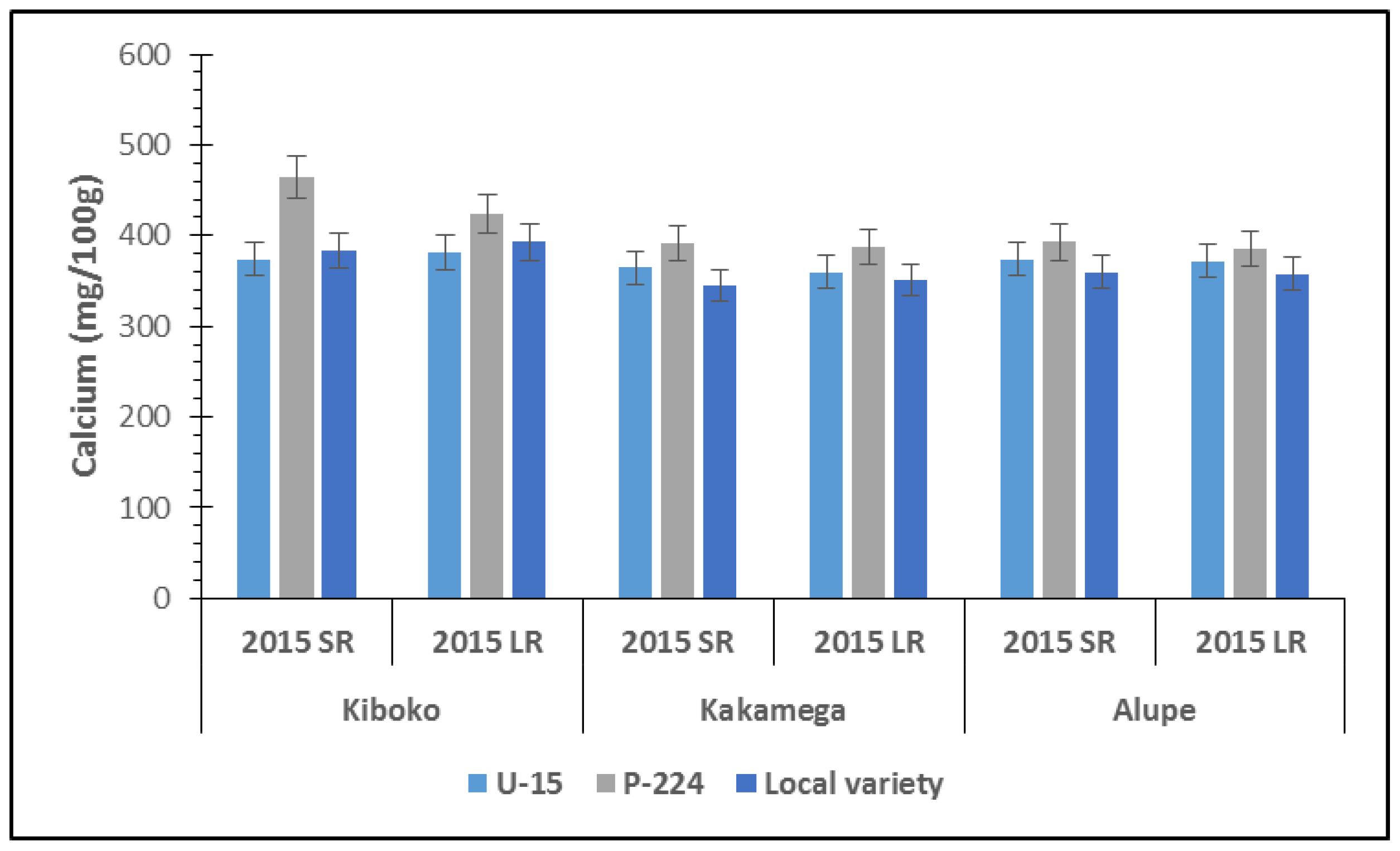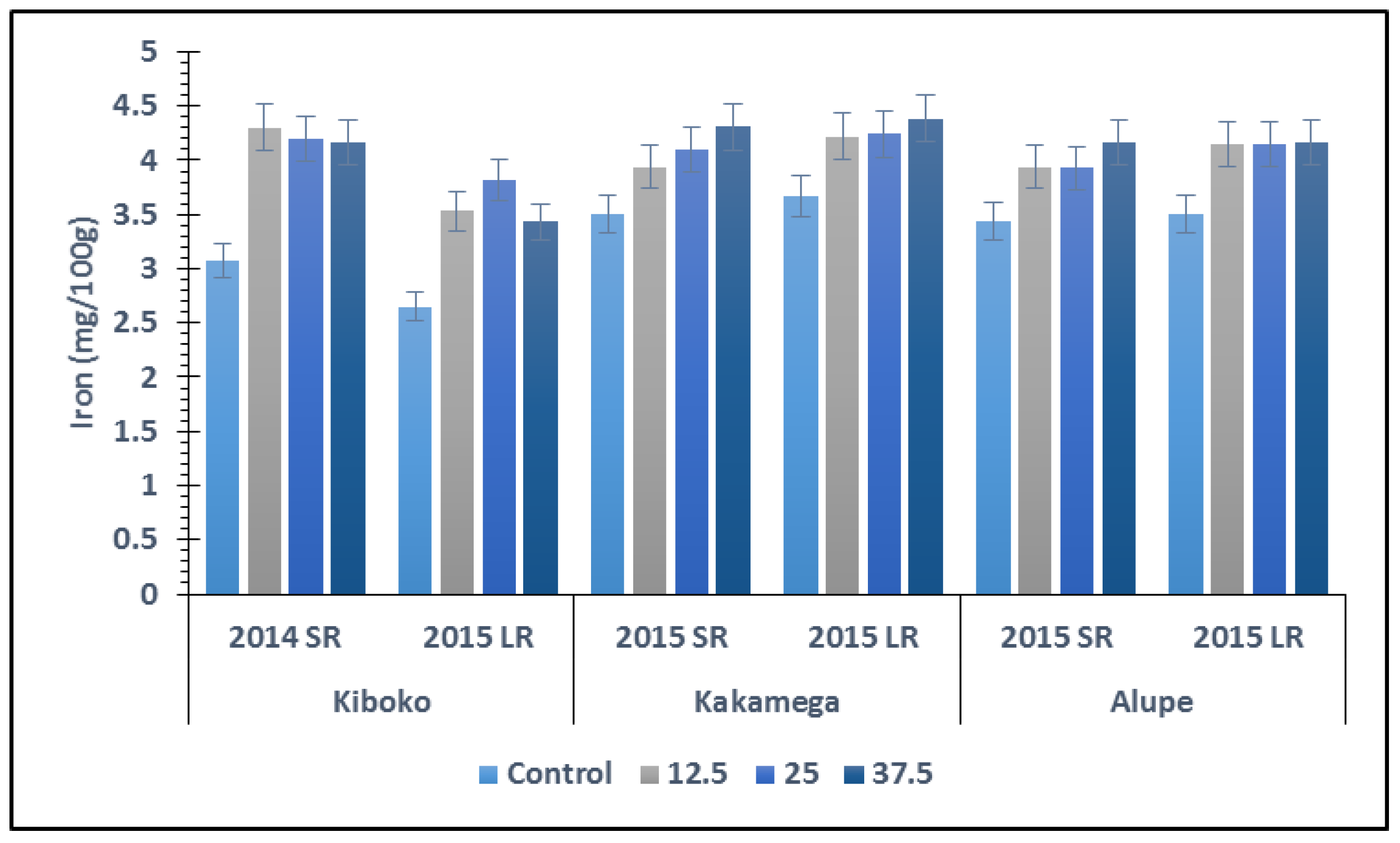Protein, Calcium, Zinc, and Iron Contents of Finger Millet Grain Response to Varietal Differences and Phosphorus Application in Kenya
Abstract
:1. Introduction
2. Materials and Methods
2.1. Description of the Experimental Sites
2.2. Experimental Design and Treatments
2.3. Laboratory Analyses
2.4. Statistical Analysis
3. Results
3.1. Grain Protein Content
3.2. Grain Calcium Content
3.3. Grain Iron Content
3.4. Grain Zinc Content
4. Discussion
5. Conclusions
Acknowledgements
Author Contributions
Conflicts of Interest
References
- Quattrocchi, U. CRC, World Dictionary of Grasses: Common Names, Scientific Names, Eponyms, Synonyms, and Etymology; CRC Press: Boca Raton, FL, USA, 2006. [Google Scholar]
- De Wet, J.M.J. Eleusine Coracana (L.) Gaertn. Record from Protabase; Brink, M., Belay, G., Eds.; PROTA (Plant Resources of Tropical Africa/Ressources végétales de l’Afriquetropicale): Wageningen, The Netherlands, 2006. [Google Scholar]
- Food and Agriculture Organization (FAO). Grassland Index. A Searchable Catalogue of Grass and Forage Legumes; FAO: Rome, Italy, 2012. [Google Scholar]
- Dida, M.M.; Devos, K.M. Finger millet. In Genome Mapping and Molecular Breeding in Plants; Chittarajan, K., Ed.; Springer: New York, NY, USA, 2006; Volume 1, pp. 333–344. [Google Scholar]
- Saleh, A.S.M.; Zhang, Q.; Chen, J.; Shen, Q. Millet grains: Nutritional Quality, Processing, and Potential Health Benefits. Compr. Rev. Food Sci. Food Saf. 2013, 12, 281–295. [Google Scholar] [CrossRef]
- Amadou, I.; Gbadamosi, O.S.; Guo-Wei, L. Millet-based traditional processed foods and beverages—A review. Cereal Food World 2011, 56, 115–121. [Google Scholar] [CrossRef]
- Izadi, Z.; Nasirpour, A.; Izadi, M.; Izadi, T. Reducing blood cholesterol by a healthy diet. Int. Food Res. J. 2012, 19, 29–37. [Google Scholar]
- Mbithi, M.S.; Ooghe, W.; Van Camp, J.; Nagundi, D.; Huyghebaert, A. Amino acid profile after sprouting, autoclaving and lactic acid fermentation of finger millet (Elusine coracana) and kidney beans (Phaseolus vulgaris L.). J. Agric. Food Chem. 2000, 48, 3081–3085. [Google Scholar] [CrossRef]
- Food and Agriculture Organization (FAO). Amino Acid Scoring Pattern. In Protein Quality Evaluation; FAO/WHO Food and Nutrition Paper: Rome, Italy, 1991; pp. 12–24. [Google Scholar]
- Obilana, A.B.; Manyasa, E. Millets. In Pseudocereals and Less Common Cereals: Grain Properties and Utilization Potential; Belton, P.S., Taylor, J.R.N., Eds.; Springer: New York, NY, USA, 2002; pp. 177–217. [Google Scholar]
- Dayakar, R.B.; Bhaskarachary, K.; Rajendra, P.M.P.; Bala, K.D.; Dhanasri, K.; Nageswara, R.T.G. Nutritional and Health Benefits of Millets; ICAR—Indian Institute of Millets Research: Rajendranagar, Hyderabad, India, 2016. [Google Scholar]
- Fairhurst, T.; Lefroy, R.; Mutert, E.; Batjes, N. The importance, distribution and causes of phosphorus deficiency as a constraint to crop production in the tropics. Agrofor. Forum 1999, 9, 2–7. [Google Scholar]
- Jama, B.; van Straaten, P. Potential of East African phosphate rock deposits in integrated nutrient management strategies. Ann. Brazil. Acad. Sci. 2006, 78, 781–790. [Google Scholar] [CrossRef]
- Association of Official Analytical Chemists (AOAC). Officials Methods of Analysis, 17th ed.; Revision 2; AOAC International: Gaithersburg, MD, USA, 2007. [Google Scholar]
- Wekha, N.W.; Nicholas, K.K.; Henry, F.O.; Moses, S.; Joseph, P.G.O. Phosphorus Influence on Plant Tissue Nitrogen Contents and Yield Attributes of Finger Millet Varieties in Semi-arid Region of Kenya. Int. J. Plant Soil Sci. 2016, 13, 1–9. [Google Scholar]
- Balconi, C.; Bosio, D.; Rizzi, E.; Nembrini, L.; Motto, M. Effects of organic and inorganic N supplies on protein and carbohydrates accumulation in high and low protein maize endosperms grown in vitro. Maydica 1997, 42, 257–264. [Google Scholar]
- Magani, I.E.; Kuchinda, C. Effects of phosphorus fertilizer on growth, yield and crude protein content of cowpea (Vigna unguculata [L.] Walp) in Nigeria. J. Appl. Biosci. 2009, 23, 1387–1393. [Google Scholar]
- Ali, S.; Mohamad, H.S. The effects of nitrogen fertilizer on ash, nitrate, organic carbon, protein and total yield of forage maize in semi-arid region of Iran. Tech. J. Eng. Appl. Sci. 2013, 3, 1680–1684. [Google Scholar]
- Togay, Y. The Effect of Different Zinc and Phosphorus Levels on the Yield and Yield Components in Lentil (Lens culinaris Medic). Ph.D. Thesis, Yuzuncu Yil University, Van, Turkey, 2002. [Google Scholar]
- Togay, Y.; Togay, N.; Dogan, Y. Research on the effect of phosphorus and molybdenum applications on the yield and yield parameters in Lentil (Lens culinaris Medic). Afr. J. Biotechnol. 2008, 7, 1256–1260. [Google Scholar]
- Goron, T.L.; Raizada, M.N. Genetic diversity and genomic resources available for the small millet crops to accelerate a new green revolution. Front. Plant Sci. 2015, 6, 157. [Google Scholar] [CrossRef] [PubMed]
- Bhoite, S.V.; Nimbalkar, V.S. Response of finger millet cultivars to nitrogen and phosphorus under rain-fed condition. J. Maharashtra Agric. Univ. 1996, 20, 189–190. [Google Scholar]
- Sarwar, G.; Hussain, N.; Schmeisky, H.; Muhammad, S.; Ibrahim, M.; Safdar, E. Use of compost an environment friendly technology for enhancing rice-wheat production in Pakistan. Pak. J. Bot. 2008, 40, 1553–1558. [Google Scholar]
- Brady, N.C.; Weil, R.R. The Nature and Properties of Soil, 13th ed.; Macmillan Publishing Co.: New York, NY, USA, 2005. [Google Scholar]
- Clemens, S.; Palmgren, M.G.; Krämer, U. A long way ahead: Understanding and engineering plant metal accumulation. Trends Plant Sci. 2002, 7, 309–315. [Google Scholar] [CrossRef]
- Rao, B.K.R.; Krishnappa, K.; Srinivasarao, C.; Wani, S.P.; Sahrawat, K.L.; Pardhasaradhi, G. Alleviation of multi-nutrient deficiency for productivity enhancement of rain-fed soybean and finger millet in the semi-arid region of India. Soil Sci. Plant Anal. 2012, 43, 1427–1435. [Google Scholar]
- Jahan, G.; Hassan, S.L.; Begum, S.N.; Islam, S.N. Identification of iron rich rice genotypes in Bangladesh using chemical analysis. J. Bangladesh Agric. Univ. 2013, 11, 73–78. [Google Scholar] [CrossRef]
- Anuradha, K.S.; Agarwal, Y.V.; Rao, K.V.; Rao, B.C.; Viraktamath, C.; Sarla, N. Mapping QTLs and candidate genes for iron and zinc concentrations in unpolished rice of Madhukar× Swarna RILs. Gene 2012, 508, 233–240. [Google Scholar] [CrossRef] [PubMed]
- Ogembo, J.O. Effects of Phosphorus Deficiency on Secondary Metabolites and Distribution of African Nightshade in Siaya and Kisii Counties, Kenya. Ph.D. Thesis, Kenyatta University, Nairobi, Kenya, 2015. [Google Scholar]
- Loneragan, J.F.; Grove, T.S.; Robson, A.D.; Snowball, K. Phosphorus toxicity as a factor in zinc-phosphorus interaction in plants. Soil Sci. Soc. Am. J. 1979, 43, 966–972. [Google Scholar] [CrossRef]
- International Food Policy Research Institute. Transform Nutrition Kenya Stakeholder Mapping Report. Available online: www.transformingnutrition.org/files/2011/11/kenya_situation_analysis.pdf (accessed on 20 December 2016).



| Busia | Kakamega | Kiboko | |
|---|---|---|---|
| pH | 5.2 | 5.6 | 9.3 |
| Phosphorus (ppm) | 5.0 | 6.0 | 13.0 |
| Nitrogen (%) | 0.03 | 0.1 | 0.08 |
| Organic Carbon (%) | 3.4 | 2.3 | 0.24 |
| Zinc (ppm) | 1.5 | 9.9 | 5.0 |
| Iron (ppm) | 28.5 | 59.3 | 41.5 |
| Calcium (%) | 10.7 | 2.8 | 2.9 |
| Kiboko | Kakamega | Alupe | |||||
|---|---|---|---|---|---|---|---|
| Variety | Kg ha−1 P2O5 | 2015 SR | 2015 LR | 2015 SR | 2015 LR | 2015 SR | 2015 LR |
| U-15 | 0 | 8.79 b | 6.56 c | 8.92 c | 10.94 c | 8.75 b | 10.94 c |
| 12.5 | 8.83 b | 8.75 b | 9.75 b | 13.13 b | 10.70 a | 15.01 a | |
| 25.0 | 11.00 a | 8.75 b | 11.8 a | 15.31 a | 10.93 a | 13.12 b | |
| 37.5 | 8.854 b | 8.75 c | 10.95 a | 10.94 c | 8.75 b | 10.94 c | |
| P-224 | 0 | 6.60 c | 4.38 d | 8.46 c | 8.88 d | 4.36 c | 8.75 d |
| 12.5 | 6.62 c | 8.75 b | 9.16 b | 13.13 b | 10.93 a | 10.94 c | |
| 25.0 | 10.96 a | 8.75 b | 9.78 b | 15.31 a | 8.73 b | 15.00 a | |
| 37.5 | 8.81 b | 8.75 b | 9.51 b | 13.13 b | 8.72 b | 13.12 b | |
| Local variety | 0 | 8.81 b | 6.56 b | 9.12 b | 10.80 c | 8.75 b | 10.94 c |
| 12.5 | 8.79 b | 8.75 b | 9.49 b | 10.94 c | 10.94 a | 10.94 c | |
| 25.0 | 10.98 a | 10.94 a | 11.48 a | 13.13 b | 10.93 a | 13.12 b | |
| 37.5 | 10.96 a | 10.94 a | 10.67 a | 13.13 b | 10.91 a | 10.94 c | |
| LSD | 0.88 | 0.91 | 0.76 | 1.04 | 0.81 | 1.12 | |
| Kiboko | Kakamega | Alupe | ||||
|---|---|---|---|---|---|---|
| Kg ha−1 P2O5 | 2015 SR | 2015 LR | 2015 SR | 2015 LR | 2015 SR | 2015 LR |
| 0 | 390 b | 382 b | 330 b | 334 c | 334 c | 340 c |
| 12.5 | 424 ab | 411 a | 349 b | 351 b | 350 b | 350 b |
| 25 | 472 a | 445 a | 388 a | 394 a | 362 b | 365 b |
| 37.5 | 343.3 c | 368 b | 389 a | 399 a | 390 a | 380 a |
| SED | 12.3 | 16.8 | 11.9 | 18.6 | 17.7 | 14.4 |
| Kg ha−1 P2O5 | Kiboko | Kakamega | Alupe | |||
|---|---|---|---|---|---|---|
| 2015 SR | 2015 LR | 2015 SR | 2015 LR | 2015 SR | 2015 LR | |
| 0 | 1.44 b | 2.83 b | 3.14 d | 3.00 c | 2.94 c | 1.60 c |
| 12.5 | 1.93 a | 3.53 a | 3.35 c | 3.22 b | 3.01 c | 1.87 bc |
| 25 | 1.63 ab | 3.43 a | 3.65 b | 3.06 c | 3.11 b | 2.10 b |
| 37.5 | 1.56 b | 3.17 a | 3.87 a | 3.28 a | 3.73 a | 2.50 a |
| Variety | ||||||
| U-15 | 1.25 c | 2.98 a | 2.95 c | 3.09 b | 3.34 b | 1.11 c |
| P-224 | 1.29 b | 2.29 b | 3.21 b | 2.83 c | 2.80 c | 1.70 b |
| Local Variety | 1.54 a | 3.05 a | 3.54 a | 3.50 a | 3.45 a | 3.25 a |
| Interaction | NS | NS | NS | NS | NS | NS |
© 2018 by the authors. Licensee MDPI, Basel, Switzerland. This article is an open access article distributed under the terms and conditions of the Creative Commons Attribution (CC BY) license (http://creativecommons.org/licenses/by/4.0/).
Share and Cite
Wafula, W.N.; Korir, N.K.; Ojulong, H.F.; Siambi, M.; Gweyi-Onyango, J.P. Protein, Calcium, Zinc, and Iron Contents of Finger Millet Grain Response to Varietal Differences and Phosphorus Application in Kenya. Agronomy 2018, 8, 24. https://doi.org/10.3390/agronomy8020024
Wafula WN, Korir NK, Ojulong HF, Siambi M, Gweyi-Onyango JP. Protein, Calcium, Zinc, and Iron Contents of Finger Millet Grain Response to Varietal Differences and Phosphorus Application in Kenya. Agronomy. 2018; 8(2):24. https://doi.org/10.3390/agronomy8020024
Chicago/Turabian StyleWafula, Wekha N., Nicholas K. Korir, Henry F. Ojulong, Moses Siambi, and Joseph P. Gweyi-Onyango. 2018. "Protein, Calcium, Zinc, and Iron Contents of Finger Millet Grain Response to Varietal Differences and Phosphorus Application in Kenya" Agronomy 8, no. 2: 24. https://doi.org/10.3390/agronomy8020024




